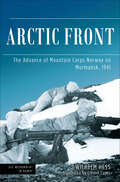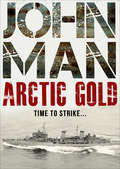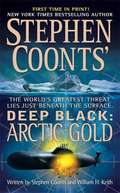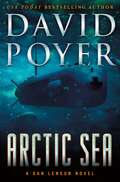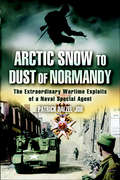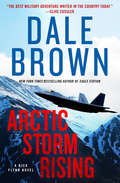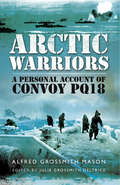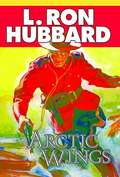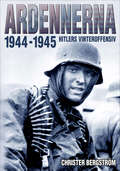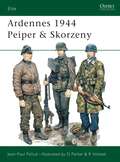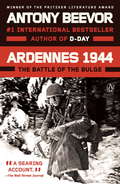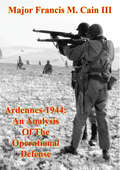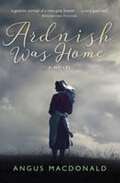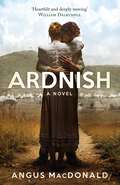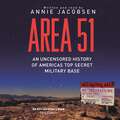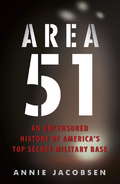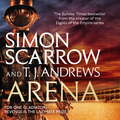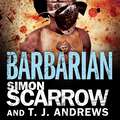- Table View
- List View
Arctic Front: Defending Canada in the Far North
by P. Whitney Lackenbauer Ken S. Coates William R. Morrion Greg PoelzerA hard-hitting, timely, and provocative book about the history and future of the Canadian Arctic. With passion and sharp words, Arctic Front confronts Canada’s longstanding neglect of the Far North and outline what needs to be done to protect our national interest. Through a lively and engaging history of the region, Arctic Front reveals how Canadians and their governments have:ignored this region for generationsexpanded Canadian sovereignty over the past hundred years by reacting to other countries’ challengesbecome the least effective of all Circumpolar nations in responding to the needs of the Arcticneglected our obligations to the North, including a failure to capitalize on the human and economic resources of this vast land or to establish a presence that would make any foreign claims to offshore resources inconceivable.As global warming continues to melt the ice in the Northwest Passage and the competition for northern resources heats up, Canada, the authors warn, will be forced to defend this area from a position of grave weakness. Our leaders need to take action today, blending defence and development, to complete Canadian nation building in this fragile region. An energetic and engaging collaboration by four of Canada’s leading Northern specialists, Arctic Front is a clarion call to all Canadians about our endangered Arctic region, challenging the country to step away from the symbols and myth making of the past and toward the urgent political, environmental and economic realities of the 21st century.
Arctic Front: The Advance of Mountain Corps Norway on Murmansk, 1941 (Die Wehrmacht im Kampf)
by Wilhelm Hess“A very thorough analysis as to why and how the combined German-Finnish army . . . ultimately failed in their quest to seize Murmansk during Barbarossa.” —Globe at WarIn 1941, military operations were conducted by large formations along the northern coast of Scandinavia—for the first time in the history of warfare. The Arctic Front was the northernmost theater in the war waged by Germany against Russia. For a period of four years, German troops from all branches of the Wehrmacht fought side by side with Finnish border guard units.The high point of the war on the Arctic Front was the assembly and advance of Germany’s Mountain Corps Norway in the summer and autumn of 1941. Commanded by general of the mountain troops, Eduard Dietl, and composed of the 2nd and 3rd Mountain Divisions, the Mountain Corps advanced out of occupied North Norway, assembled in the Petsamo Corridor in North Finland, and struck into Russian territory in an attempt to seize Murmansk. It did not reach its objective. This account of the operation was written by Wilhelm Hess, quartermaster of the Mountain Corps Norway. He draws upon his personal experience of the conditions and actions on the Arctic Front in order to describe and analyze the environment, the sequence of events, and the reasons behind certain decisions. In addition to describing how operations conducted by the Mountain Corps unfolded, Hess provides insight as to how the terrain, the flow of supplies, and the war at sea impacted those operations.“A serious, thoughtful book about war . . . in conditions hardly conducive to survival, let alone combat.” —Stone & Stone
Arctic Gold
by John ManA man searches for the sunken treasure he once protected as a sailor in WWII in this “thrilling action story” from the acclaimed historian (Tom Kasey, author of Trade Off). Murmansk, Russia, 1942. The HMS Edinburgh is sailing deep in Russian territory, a bulwark against Nazi invaders. Among the eight-hundred-strong crew is Mike Cox, a sixteen-year-old boy from the East End, London who is about to be thrown into the heat of war. A Russian ship approaches the Edinburgh with a very precious cargo—over a thousand tons of gold—as payment from the Soviet Union for the Royal Navy’s protection. Now the English ship is tasked with safeguarding a fortune as well as the Barents Sea. But when a German U-boat fires torpedoes at the Edinburgh’s hull, the crew must fight for their lives . . . and Mike is one of only a few survivors to escape from the wreck as the gold sinks eight hundred feet to the bottom of the sea. After making his way back to London, Mike finds himself more alone than ever. He starts training to become a diver with one objective in mind: to rescue that precious Arctic gold. But he’ll have to act quick—he’s not the only one looking for it . . .
Arctic Gold (Deep Black #7)
by Stephen Coonts William H. KeithIn the Arctic, two American intelligence operatives are kidnapped while investigating Russian submarines—a constant, covert presence beneath the ice caps. In Washington, ex-Marine Charlie Dean and his team at Desk Three trace the abduction back to the Russian mafiya, who have their sights set on the massive reserves of oil that lie thousands of feet below the ocean's floor. While Dean is sent to the Arctic to rescue the hostages, the beautiful Lia DeFrancesca penetrates a heavily guarded dacha on the shores of the Black Sea. There she learns the explosive truth about Russia and its Arctic oil—one that could cost Dean and his Deep Blackteam their lives...and drive the world's superpowers to the brink of war.
Arctic Sea: A Dan Lenson Novel (Dan Lenson Novels #21)
by David PoyerNew threats surface in the aftermath of WWIII—this time, in the remote waters of the Arctic.Arctic Sea is the next thrilling entry in David Poyer's critically-acclaimed future war series. In the aftermath of a world war with China, Admiral Dan Lenson is assigned to set up a US Navy base on the rugged North Slope of Alaska, in response to Russian seabed claims that reach nearly to the US coast. Yet the current administration seems oddly reluctant to confront Russian aggression. At the same time, the International Criminal Court is accusing Dan of a war crime.Back in Washington, Blair Titus is running Jim Yangerhans’s campaign for president, while Dan’s daughter Nan battles disease in a radiation-soaked Midwest. But when Moscow plans to test the Apocalyps, a nuclear powered citykiller torpedo, in the Arctic Sea, Dan is sucked into a perilous covert mission. Will a barely victorious America survive dangerous new threats...both from without, and within?
Arctic Snow to Dust of Normandy: The Extraordinary Wartime Exploits of a Naval Special Agent
by Patrick Dalzel-JobVery few men have a more exciting and dramatic story of their wartime activities to tell than Patrick Dalzel-Job. In 1940 using his special knowledge of North Norway's coast line he landed and moved over 10,000 Allied soldiers in local boats without the loss of a single life. Acting against specific orders he evacuated civilians from Narvik just before it was bombed—only the King of Norway's intervention halted his court martial. Thereafter his many adventures included spying on enemy shipping and operating behind the lines in France and Germany with Ian Fleming's special force unit '30AU'.
Arctic Storm Rising: A Novel (Nick Flynn #1)
by Dale BrownFirst in a new series from New York Times bestselling author Dale Brown, featuring U.S. Air Force intelligence officer Nick Flynn on the hunt for Russian commandos in the mountains of Alaska.After a CIA covert mission goes badly awry, U.S. Air Force intelligence officer Nicholas Flynn is exiled to guard a remote radar post along Alaska’s Arctic frontier. This dead-end assignment is designed to put his career permanently on ice, but Flynn’s not the type to fade quietly into obscurity... As winter storms pound Alaska and northern Canada, Russian aircraft begin penetrating deep into friendly airspace. Are these rehearsals for a possible first strike, using Russia’s new long-range stealth cruise missiles? Or is some other motive driving the Kremlin to take ever-increasing risks along the hostile Arctic frontier separating two of the world’s great powers? When an American F-22 collides with one of the Russian interlopers, things go south fast—in seconds, missiles are fired. There are no survivors. Despite horrific weather, Flynn and his security team are ordered to parachute into the area in a desperate bid to reach the crash sites ahead of the Russians. It’s now obvious that the Pentagon and CIA are withholding vital information, but Flynn and his men have no choice but to make the dangerous jump. Soon they’re caught in a deadly game of hide-and-seek with Spetsnaz commandos operating covertly on American soil. It seems that the F-22s and their Russian counterparts aren’t the first aircraft to have gone missing in these desolate mountains. The Kremlin is hunting for the first prototype of its new stealth bomber—which vanished on what was supposed to be a test flight…while loaded with nuclear-armed stealth cruise missiles. As Russia and the U.S. square off on the brink of all-out-war, it’s up to Nick to find the missing bomber…and prevent a potential nuclear holocaust.
Arctic Sun: A Grumpy Sunshine MM Romance (Frozen Hearts)
by Annabeth AlbertHe&’s built a quiet life for himself in Alaska. But it doesn&’t stand a chance against the unrelenting pull of a man who&’s everything he shouldn&’t want.&“Whether making my heart melt or my head burst into flames, Annabeth Albert draws the reader in and keeps them captivated.&” —Gay Book ReviewsGriffin As an ex-military mountain man, I like my solitude. It keeps me from falling back into old habits. Bad habits. I&’ve fought too hard for my sobriety to lose control now. This new gig as a wildlife guide is presenting itself with a whole new kind of temptation in the form of superhot supermodel River Vale. Nothing the Alaskan wilderness has to offer has ever called to me so badly. And that can only lead to trouble… The closer I get to River, the easier it is to ignore every reason I should run.RiverChasing adventure means always moving forward. Nobody&’s ever made me want to stand still before—until Griffin Barrett. The rugged bush pilot is the best kind of distraction, but the emotions he&’s stirring up in me are starting to feel anything but casual, and I&’m in no position to stay put. With temptation lurking in close quarters, keeping even a shred of distance between us seems to be a challenge neither of us is willing to meet. Previously published Frozen Hearts Book 1: Arctic Sun Book 2: Arctic Wild Book 3: Arctic HeatAlso by Annabeth Albert:Shore Leave Book 1: Sailor Proof Book 2: Sink or SwimOut of Uniform Book 1: Off Base Book 2: At Attention Book 3: On Point Book 4: Wheels Up Book 5: Squared Away Book 6: Tight Quarters Book 7: Rough Terrain
Arctic Sun: An Alaska Romance (Frozen Hearts #1)
by Annabeth AlbertEverything’s bigger in Alaska, especially the HEAs. Annabeth Albert kicks off the brand-new Frozen Hearts series with Arctic Sun, an opposites-attract romance between a rugged outdoorsman and a smoking hot former male model.He’s built a quiet life for himself in Alaska. But it doesn’t stand a chance against the unrelenting pull of a man who’s everything he shouldn’t want.Ex-military mountain man Griffin Barrett likes his solitude. It keeps him from falling back into old habits. Bad habits. He’s fought too hard for his sobriety to lose control now. However, his gig as a wildlife guide presents a new kind of temptation in superhot supermodel River Vale. Nothing the Alaskan wilderness has to offer has ever called to Griffin so badly. And that can only lead to trouble…River has his own methods for coping. Chasing adventure means always moving forward. Nobody’s ever made him want to stand still—until Griffin. The rugged bush pilot is the very best kind of distraction, but the emotions he stirs up in River feel anything but casual, and he’s in no position to stay put.With temptation lurking in close quarters, keeping even a shred of distance is a challenge neither’s willing to meet. And the closer Griffin gets to River, the easier it is to ignore every last reason he should run.One-click with confidence. This title is part of the Carina Press Romance Promise: all the romance you’re looking for with an HEA/HFN. It’s a promise!Publisher’s Note: Arctic Sun deals with topics some readers may find difficult, including sobriety and eating disorders.This book is approximately 95,000 words
Arctic Warriors: A Personal Account of Convoy PQ18
by Deltrice Alfred Grossmith Julie Grossmith DeltriceIn mid-1942 Alfred Grossmith Mason became Navigation/Gunnery Officer on SS Empire Baffin, a 6,978 ton cargo ship assigned to carry essential war supplies to the hard pressed Soviet Union. Fortunately he compiled this remarkable diary of the dramas and disasters that befell the ill-fated Convoy PQ18. This inspiring story follows the movement of his ship and the other merchantmen together with their Royal Naval escorts from the mustering point at Loch Ewe to their destination Archangel.Daily German attacks from the air and sea and long periods at action stations deprived crews of sleep. The loss of many ships and comrades and the ever-present prospect of death through drowning and hypothermia took their toll. Having to function while exhausted, ill-nourished and freezing cold demanded that every man gave of his utmost over a prolonged period. Yet remarkably, as this book shows, humour remained intact.Once in Archangel his insight into the hardships faced by the Russian population is revealing. For the surviving sailors there remained the awesome challenge of the return journey without any escort. Unlike so many, the Author finally reached Britain in December 1942.Arctic Warriors is a rare and graphic personal account that captures the atmosphere of this infamously costly convoy and others like it. If any doubts remain of the terrible conditions and dangers that merchant seamen aced in the hostile waters of the North Atlantic and Barents Sea, this superb record, published in the Year of the Convoy, will surely put them to rest.
Arctic Wings
by L. Ron HubbardSpring has come to White Bear Landing--and so has the law, in the firm hands of Royal Mounted policeman and pilot Bob Dixon. Dixon's as gruff, tough and good-looking as Russell Crowe, and in this outpost halfway between the arctic mines and civilization, he's known for taking the law to extremes.More than once Dixon has meted out his own brand of rough justice with hard fists and hot lead, but now the tables have turned. The past has come back to haunt him, he's been set up as a murder suspect, and a rogue's gallery of enemies are lining up to settle old scores . . .Out on the icy tundra, on the edge of the world, revenge can be cold--and brutal. Dixon's only hope is to let the trust of a good friend and the love of a good woman lead the way to true justice and redemption--on Arctic Wings.Hubbard never wrote a word, conceived a character, or described a setting without first finding out all he could about the people and places that drove his stories. He wrote: "I began to search for research on the theory that if I could get a glimmering of anything lying beyond a certain horizon, I could go deep enough to find an excellent story. I read exhaustively. I wanted information and nothing else." His exhaustive research--and search for the excellent story--comes through brilliantly in Arctic Wings.
Ardennerna 1944–1945: Hitlers Vinteroffensiv
by Christer BergströmI december 1944, precis i slutet av andra världskriget, chockade Hitler en hel värld med en mäktig tysk motoffensiv på västfronten. För andra gången i kriget blev de allierade helt överrumplade av att anfallet kom genom Ardennerna - det kuperade skogsområdet i östra Belgien och Luxemburg. De trodde fortfarande att det inte gick att föra fram en stor armé där, men blev snabbt varse hur fel de haft. Till synes oövervinneliga rullade stora tyska stridsvagnskolonner västerut. Den allra senaste tyska vapenteknologin koncentrerades till denna offensiv - väldiga Königstiger-stridsvagnar, en revolutionerande ny automatkarbin, flygande bomber och toppmoderna jetflygplan. Tyskarna satte till och med in eldrivna miniubåtar till stöd för Ardenneroffensiven! Halva amerikanska 1. armén kastades över ända och tusentals soldater togs tillfånga. Men i en liten stad, Bastogne, bet sig amerikanska fallskärmsjägare fast. Under tiden skyndade den hårdföre general Pattons armé till undsättning. Ändå krävdes det ett sex veckor långt, blodigt vinterslag - det mest förlustrika i den amerikanska arméns historia - innan tyskarna hade pressats tillbaka. Christer Bergström har intervjuat krigsveteraner, gått igenom stora mängder akrivmaterial samt rest och forskat i området. Resultatet är en stor mängd tidigare opublicerat material och nya rön som presenteras i denna genomgripande skildring av det dramatiska Ardennerslaget vintern 1944/1945. Ardennerslaget beskrivs ofta från den amerikanska utgångspunkten. Här ges båda sidors perspektiv lika stort utrymme. Inte minst lyfts veteranernas egna berättelser fram, vilket ger en mänsklig dimension åt detta blodiga slag. Boken är försedd med nära 400 illustrationer, inklusive ett stort antal aldrig tidigare publicerade fotografier, ett stort antal kartor av Samuel Svärd och 32 förstklassiga färgprofiler av stridsfordon och flygplan av den världskände profilartisten Claes Sundin. Christer Bergström, f. 1958, har ett 20-tal böcker om andra världskriget, flertalet utgivna på den internationella marknaden, bakom sig.
Ardennes 1944 Peiper & Skorzeny
by David Parker Jean-Paul PalludFrom the earliest planning stages of the German counter-offensive in the Ardennes during World War II (1939-1945), Hitler was convinced of the importance of taking the Meuse bridges. He resolved that, when his forces broke through the US lines, one special unit should be dressed in American uniforms and issued with American weapons and vehicles. In this guise they could take advantage of the surprise and shock of the breakthrough, and move forward to the Meuse bridges as if they were retreating Americans. Jean-Paul Pallud details their organisation and the fateful sequence of events that followed.
Ardennes 1944: The Battle of the Bulge
by Antony BeevorThe prizewinning historian and bestselling author of D-Day and Stalingrad reconstructs the Battle of the Bulge in this riveting new account. On December 16, 1944, Hitler launched his 'last gamble' in the snow-covered forests and gorges of the Ardennes in Belgium, believing he could split the Allies by driving all the way to Antwerp and forcing the Canadians and the British out of the war. Although his generals were doubtful of success, younger officers and NCOs were desperate to believe that their homes and families could be saved from the vengeful Red Army approaching from the east. Many were exultant at the prospect of striking back.The allies, taken by surprise, found themselves fighting two panzer armies. Belgian civilians abandoned their homes, justifiably afraid of German revenge. Panic spread even to Paris. While some American soldiers, overwhelmed by the German onslaught, fled or surrendered, others held on heroically, creating breakwaters which slowed the German advance. The harsh winter conditions and the savagery of the battle became comparable to the Eastern Front. In fact the Ardennes became the Western Front's counterpart to Stalingrad. There was terrible ferocity on both sides, driven by desperation and revenge, in which the normal rules of combat were breached. The Ardennes--involving more than a million men--would prove to be the battle which finally broke the back of the Wehrmacht. In this deeply researched work, with striking insights into the major players on both sides, Antony Beevor gives us the definitive account of the Ardennes offensive which was to become the greatest battle of World War II.From the Hardcover edition.
Ardennes-1944: An Analysis Of The Operational Defense
by Major Francis M. Cain IIIThis study examines the nature of the defense at the operational level of war by analyzing the Battle of the Bulge in Dec. 1944 using the concepts of blitzkrieg and "web" defense. The monograph begins by discussing the influence of defensive theory on the operational concepts of blitzkrieg and "web" defense. The German concept of blitzkrieg incorporates Clausewitz's theory of the offense by emphasizing surprise, speed, and concentration at the decisive point. The counter to the blitzkrieg offense is found in COL F.O. Miksche's concept of "web" defense. The Battle of the Bulge provides an excellent example of a "web" defense pitted against a blitzkrieg offense. The German blitzkrieg in the Ardennes in 1944 failed for many reasons: 1) Army Group B did not concentrate its strength against the most vulnerable section of the Allied line; 2) The rugged Ardennes terrain could be easily defended against attacks by mechanized forces; 3) Key American commanders (Eisenhower, Gerow, and Middleton) quickly recognized the value of holding several key road junctions (St. Vith, Malmedy, Bastogne, Marche, and Rochefort) which dominated movement through the Ardennes; 4) The Allies held the shoulders of the German penetration; 5) The Allies quickly concentrated armored and motorized units to blunt the German penetration; and 6) Army Group B lacked operational reserves and adequate logistic support. The analysis of the Ardennes shows that the defense is indeed the stronger form of war and that a "web" defense can be employed effectively against a blitzkrieg offense...The Allies effectively used a "web" defense to counter these threats. If NATO is to defeat a Soviet attack without resorting to the use of nuclear weapons, it must adopt a viable operational defensive concept. "Web" defense is such a concept.
Ardnish Was Home: A Novel (Ardnish Ser.)
by Angus MacDonaldStationed in Gallipoli during WWI, a wounded Scottish soldier finds love as he longs for home in this novel of memory, romance and the horror of war.Gallipoli, 1916. A soldier in the British Army&’s Lovat Scouts, Young Donald Peter Gillies, lies in a hospital bed, blinded by the Turks. There by his side is Louise, a Queen Alexandra Corps nurse, Louise, who cares for him and listens to his stories of home. Donald paints a vivid picture of the western highlands coast, telling stories of how his family lived: bagpiping, sheep shearing, celidhs, illegal distilling, his mother saving the life of the people of St Kilda, the navvies building the west highland railway and the relationship between the lairds and the people. Louise in turn tells her own story of growing up in the Welsh valley: coal mining, a harsh and unforgiving upbringing. But when they suddenly find themselves cut off from the allied troops, they must make a daring escape through Turkey to Greece. The first novel in Angus MacDonald&’s acclaimed trilogy begins an epic tale spanning generation of war and of a single Scottish family.
Ardnish: A Novel
by Angus MacDonaldThis saga spanning from the Scottish Highlands to colonial South Africa is “far more than yet another wartime love story . . . impossible to put down”(Scottish Field).Ardnish, the Highlands of Scotland, 1944: On his deathbed, Donald John Gillies sends for a priest to hear his last confession. During his eighty-five years he has witnessed much—world wars, the loss of family through death and emigration, and the daily struggles faced by the small remote community.Waiting anxiously for the priest, his mind travels back to the dusty plains of South Africa in 1901, where he fought as a Lovat Scout during the Boer War, and where he met the woman who was the love of his life. Forced to abandon her and her young daughter in a British concentration camp, DJ returns to Scotland and his old life after his camp is ambushed by Boers and many of his fellow soldiers are massacred.As he lies dying, an unexpected visitor arrives at Ardnish. making it more imperative then ever for DJ to come to terms with the past and to make peace with himself—and his family—while there is still time, in this “ingeniously plotted” novel that “sweeps the reader from the smokey peat fires of the West Highlands to the baking sun of the South African veldt at the height of the Boer War” (William Dalrymple).
Are They Out There?: Diving for Answers In a Sea of Cover-Ups
by Gene P. Abel&“If you're ready to read a realistic approach to the possibility of alien life and whether we are visited by them, you will love Are They Out There? Diving for Answers In a Sea of Cover-Ups.&” – Readers&’ FavoriteNothing in the universe is unique and alone, and therefore in other regions there must be other earths inhabited by different tribes of men and different breeds of beast. - Titus Lucretius, De Rerum Natura circa 50BCE The question, Are They Out There? is not a new one. Since ancient times, humans have wondered about the potential of alien life. Between May 1, 2023, and June 1, 2024, alone, sightings of more than seven hundred unidentified aerial phenomena were reported-and twenty-one of these cases are still under investigation. They can't be explained by common objects. In Are They Out There? retired Colonel Gene P. Abel sifts through the accounts of military professionals and eyewitnesses alike in search of the truth about extra-terrestrial visitors. Discover what Colonel Abel has uncovered, and what the government might not be telling us, in this gripping new look at the history, and potential future impact, of UFOs, and alien contact. A newly released US report on unidentified flying objects says 143 sightings since 2004 remain unexplained. It does not rule out alien activity. - The New York Times, June 25, 2021
Are U.S. Military Interventions Contagious over Time?: Intervention Timing and Its Implications for Force Planning
by Jennifer KavanaghCurrent DoD force planning processes assume that U. S. military interventions are serially independent over time. This report challenges this assumption, arguing that interventions occur in temporally dependent clusters in which the likelihood of an intervention depends on interventions in the recent past. The author used data on 66 U. S. Army contingency and peacekeeping deployments of at least company size between 1949 and 2010 and found evidence of temporal dependence between military interventions even when controlling for political, economic, and other security factors. However, the results also suggested that clustering is affected by the nature of the geopolitical regime and is stronger at certain points than others, for example, after the Cold War as compared to during the Cold War. The results suggested that as few as two military interventions above average is often enough to trigger interventions in subsequent years. Because current planning processes address only the direct force demands of a given deployment and ignore the heightened risk for additional demands created by temporal dependence, these processes may project force requirements that understate the demands placed on military deployments during a period of clustered interventions. This analysis suggests that DoD should consider modifying the integrated security constructs to incorporate serial correlation of interventions, making assumptions about the nature of the current or future geopolitical regime explicit, and assessing whether the existing set of force planning frameworks reflects the spectrum of potential future geopolitical regimes. Book jacket.
Area 51: An Uncensored History of America's Top Secret Military Base
by Annie JacobsenIt is the most famous military installation in the world. And no credible insider has ever divulged the truth about his time inside of it. Until now. This is the first book based on interviews with scientists, pilots, and engineers - 58 in total - who provide an unprecedented look into the mysterious activities of a top-secret base, from the Cold War to today. With a jaw-dropping ending, it proves that facts are often more fantastic than fiction, especially when the distinction is almost impossible to make.Read by Annie Jacobsen(p) 2011 Hachette Audio
Area 51: An Uncensored History of America's Top Secret Military Base
by Annie JacobsenThe explosive, untold story of the Cold War's biggest secret from the bestselling author of NUCLEAR WAR: A SCENARIO'An extraordinary book' DAILY EXPRESS'Revelatory . . . the research is compellingly hard-hitting' NEW YORK TIMESIt is the most famous military installation in the world. And no credible insider has ever divulged the truth about his time inside of it. Until now. This is the first book based on interviews with scientists, pilots, and engineers - 58 in total - who provide an unprecedented look into the mysterious activities of a top-secret base, from the Cold War to today. With a jaw-dropping ending, it proves that facts are often more fantastic than fiction, especially when the distinction is almost impossible to make.
Arena
by Simon Scarrow T. J. AndrewsARENA is a Sunday Times bestselling novel from Simon Scarrow, author of CENTURION, THE GLADIATOR and BRITANNIA, and T.J. Andrews. Perfect for fans of Bernard Cornwell.It is AD 41. The city of Rome is a dangerous place. Optio Macro of the Second Legion, recently decorated for courage on the battlefield, can't wait to leave the teeming city behind. He's dismayed when he's compelled to stay in Rome to train Marcus Valerius Pavo, a young gladiatorial recruit. Though fearless Pavo has fought for his life before, he's a novice in the arena. But he's a driven man, with a goal dearer than survival - to avenge his father's death at the hands of a champion gladiator. Will he live to face his nemesis?ARENA has previously been published as five separate ebook novellas. This edition brings the complete series together.
Arena
by Simon Scarrow T. J. AndrewsARENA is a Sunday Times bestselling novel from Simon Scarrow, author of INVICTUS, CENTURION and THE GLADIATOR, and T.J. Andrews. Perfect for fans of Bernard Cornwell. Praise for Simon Scarrow's gripping novels: 'Ferocious and compelling' Daily ExpressIt is AD 41. The city of Rome is a dangerous place.Optio Macro of the Second Legion, recently decorated for courage on the battlefield, can't wait to leave the teeming city behind. He's dismayed when he's compelled to stay in Rome to train Marcus Valerius Pavo, a young gladiatorial recruit. Though fearless Pavo has fought for his life before, he's a novice in the arenas. But he's a driven man, with a goal dearer than survival - to avenge his father's death at the hands of a champion gladiator. Will he live to face his nemesis?ARENA has previously been published as five separate ebook novellas. This print edition brings the complete series together.(P)2013 Headline Publishing Group Ltd
Arena: Barbarian (Part One of the Roman Arena Series)
by Simon Scarrow T. J. AndrewsThe first in a series of action-packed novellas set in Ancient Rome introducing Pavo, a novice gladiator, and featuring Simon Scarrow's ongoing soldier character Optio Macro.It is AD 41. The savage Gaul Britomaris has defeated the best of the Roman gladiators in the arena. Now a young volunteer, Marcus Valerius Pavo, the son of a murdered general, has been given a month to prepare to face Britomaris in a fight which only one man can survive. He is to be trained by veteran soldier Macro, who fears for his young trainee's chances. But Pavo is motivated by more than a simple desire for victory or survival, and Britomaris may yet be facing his most dangerous opponent...
Arena: Barbarian (Roman Arena #1)
by Simon Scarrow T. J. AndrewsThe first in a series of action-packed novellas set in Ancient Rome introducing Pavo, a novice gladiator, and featuring Simon Scarrow's ongoing soldier character Optio Macro.It is AD 41. The savage Gaul Britomaris has defeated the best of the Roman gladiators in the arena. Now a young volunteer, Marcus Valerius Pavo, the son of a murdered general, has been given a month to prepare to face Britomaris in a fight which only one man can survive. He is to be trained by veteran soldier Macro, who fears for his young trainee's chances. But Pavo is motivated by more than a simple desire for victory or survival, and Britomaris may yet be facing his most dangerous opponent...(P)2018 Headline Publishing Group Ltd

